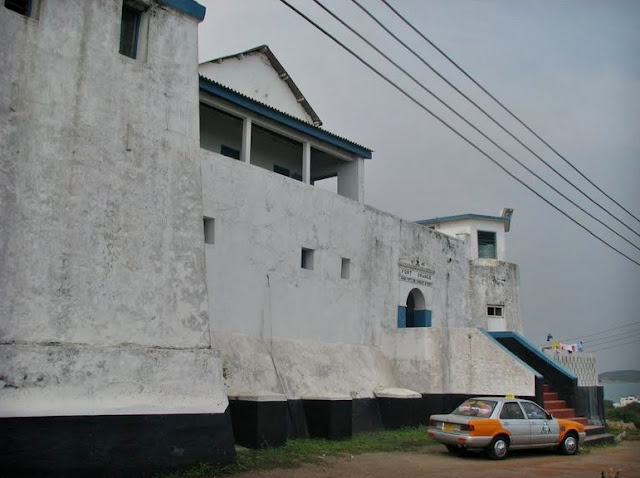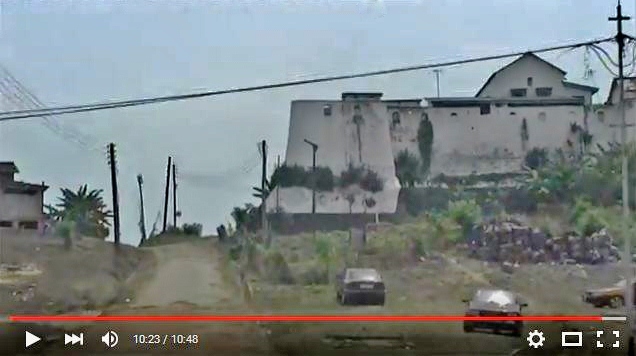Young tour-guide and it´s little brother at Fort Orange Sekondi
Photography : Mae-Ling Lokko / wordpress.com
Compared with the Nassau Fortress at Mouri, no doubts about it´s history or real existence surround the Fort Orange or Oranje in Sekondi, the capital of Ghanaian Western Province situated 60 kilometers southwest of Moreé. It exists still in it´s last reconstructed shape from 1704 meanwhile a second fortress constructed probably by the British Trade Companies in it´s inmediate neighbourhood at the Sekondi harbourside in the year 1682 has disappeared nearly completely and it´s only remains are the ruins of a former tower.
The good conservation and maintainance condition of the fortress founded in the year 1642 as Trading Post and lodge building by the Netherland East India Company is explainable due to the use of the construction as lighthouse and naval base by the Ghana Ports and Harbour Authorities since 1872, when it was sold together with the rest of the Dutch crowns possessions at the Ghanaian Gold Coast to the British Empire.
This could be already the essence of the present description, but most publications about FORT ORANJE SEKONDI in Internet give more or less clear details about a rather complicated conflict history since the foundation of the settlement in Ghana, so that some of these aspects must be attached here to avoid final accounting of lost properties by former owners.
During the first 50 years of existence of the "Dutch Trading Post" at Sekondi, between 1642 and 1694, the historical situation was marked by multiple competences between the european countries that established new "markets" in Westafrica as well as between native inhabitants of the countries that probably acted in alliances with one or other of the foreign flags. As well as "attacks of Portuguese", who burned down native settlements around the Trade Posts, are described "British intentions of weakening the Dutch stronghold at the Gold Coast" by elevating in gunrange of existing fortresses competing battle stations.
Much more numerous than the conflicts between the competing europeans must have been the conflicts generated between the mercenaries retained inside the fortresses and the civil population that has been more or less rough submitted to slave trade by the european intruders. During one of these attacks of "indigenous people" in September 1694 the Dutch Trade Post in Sekondi must have got destroyed. The available literature names as responsables the civil rebels called "HANTA, AHANTA or AHATANTA".
The answer from the Netherlands was drawing up an arquitectonic reconstruction plan of the lost Trade Post as fortified battle station with blinded, high walls, loopholes, canons and probably also catacombs. The planned construction was lifted up in 1704 - 311 years ago from today.
The fact, that the guns of the new constructed Fort Orange pointed towards the neighbour British fortification could be an indication, that a certain alliance might have existed between Ahanta and Englishmens. In this logic is told, that the english construction was destroyed already 4 years later in 1698, also by a competing Ahanta rebel group and 6 years before Fort Orange was reconstructed - what excludes the participation of the latter in the battle (Source : Ghana Expeditions). Consequently "The English" rebuild their fortress so that the actual condition of the building probably is the result of the recapturing by "The French" in 1797.
So far, the drawn attention on tales, myths and justifications of historic facts and phantasies could distance again from that object of observation. The actual problems of West-Africa consist in uprising the level of wealth for the whole population and the protection of the less privileged parts of the native societies. For example between December 2013 and December 2015 the so called "EBOLA-epidemia" in the western neighbour countries of Ghana killed around 11.000 persons, probably from less privileged social strata. The epidemias consecuences contributed to a refugee migration wave from the affected countries northward during 2014 and 2015. In their intent to cross the mediterranean sea towards the European Community countries with improvised vessels another unknown greater amount of persons lost their lives. Due to the difficult adaption to life and climate in the actual northern host countries probably a greater amount of the of the african citizens, that actually survive there, will have to return to their sites of origin. The fact, that the possibility of an pretended genocide by poisoning as reason for the sudden high death rate of native persons is discussed, shows clearly, that the historic problems related to colonial activities 400-100 years ago distract from an somewhat more virulent present. As example might be given here the somewhat suspicious preventive attitude of european "care and health associations" with their most actual "preparations" for an "expected future Ebola crisis" in Ghana. The country "until now" has not suffered this epidemia, says an article in german Internet from April 2015.
So, having considered the walls of Fort Nassau in Moreé as useful windshield for the comunitary kitchen fireplaces of traditionally cooking woman, could be then the future of Fort Orange also be the one of an protected preparation site of traditional dishes without risk of integrating contaminated water or rice in the dayly breakfast, supper or dinner ? Why not !
View from Fort Orange on Sekondi Harbour Hilltop towards the harbour,
where remains of the tower of a second fortress are visible.
The good conservation and maintainance condition of the fortress founded in the year 1642 as Trading Post and lodge building by the Netherland East India Company is explainable due to the use of the construction as lighthouse and naval base by the Ghana Ports and Harbour Authorities since 1872, when it was sold together with the rest of the Dutch crowns possessions at the Ghanaian Gold Coast to the British Empire.
Photography : ghana.net.com
This could be already the essence of the present description, but most publications about FORT ORANJE SEKONDI in Internet give more or less clear details about a rather complicated conflict history since the foundation of the settlement in Ghana, so that some of these aspects must be attached here to avoid final accounting of lost properties by former owners.
During the first 50 years of existence of the "Dutch Trading Post" at Sekondi, between 1642 and 1694, the historical situation was marked by multiple competences between the european countries that established new "markets" in Westafrica as well as between native inhabitants of the countries that probably acted in alliances with one or other of the foreign flags. As well as "attacks of Portuguese", who burned down native settlements around the Trade Posts, are described "British intentions of weakening the Dutch stronghold at the Gold Coast" by elevating in gunrange of existing fortresses competing battle stations.
Much more numerous than the conflicts between the competing europeans must have been the conflicts generated between the mercenaries retained inside the fortresses and the civil population that has been more or less rough submitted to slave trade by the european intruders. During one of these attacks of "indigenous people" in September 1694 the Dutch Trade Post in Sekondi must have got destroyed. The available literature names as responsables the civil rebels called "HANTA, AHANTA or AHATANTA".
The answer from the Netherlands was drawing up an arquitectonic reconstruction plan of the lost Trade Post as fortified battle station with blinded, high walls, loopholes, canons and probably also catacombs. The planned construction was lifted up in 1704 - 311 years ago from today.
Reconstruction Plan for the Sekondi Trade Post drawn up in the Netherlands around 1700.
The fact, that the guns of the new constructed Fort Orange pointed towards the neighbour British fortification could be an indication, that a certain alliance might have existed between Ahanta and Englishmens. In this logic is told, that the english construction was destroyed already 4 years later in 1698, also by a competing Ahanta rebel group and 6 years before Fort Orange was reconstructed - what excludes the participation of the latter in the battle (Source : Ghana Expeditions). Consequently "The English" rebuild their fortress so that the actual condition of the building probably is the result of the recapturing by "The French" in 1797.
Painting of a peaceful neighbourhood that not existed always. The artist describes "pleasant and fertile gardens, delicious fish, mullets and oysters" and "natives in peace that provide elephant teeth and slaves" around the Dutch and British Fortresses at Sekondi
Source : Wikipedia
So far, the drawn attention on tales, myths and justifications of historic facts and phantasies could distance again from that object of observation. The actual problems of West-Africa consist in uprising the level of wealth for the whole population and the protection of the less privileged parts of the native societies. For example between December 2013 and December 2015 the so called "EBOLA-epidemia" in the western neighbour countries of Ghana killed around 11.000 persons, probably from less privileged social strata. The epidemias consecuences contributed to a refugee migration wave from the affected countries northward during 2014 and 2015. In their intent to cross the mediterranean sea towards the European Community countries with improvised vessels another unknown greater amount of persons lost their lives. Due to the difficult adaption to life and climate in the actual northern host countries probably a greater amount of the of the african citizens, that actually survive there, will have to return to their sites of origin. The fact, that the possibility of an pretended genocide by poisoning as reason for the sudden high death rate of native persons is discussed, shows clearly, that the historic problems related to colonial activities 400-100 years ago distract from an somewhat more virulent present. As example might be given here the somewhat suspicious preventive attitude of european "care and health associations" with their most actual "preparations" for an "expected future Ebola crisis" in Ghana. The country "until now" has not suffered this epidemia, says an article in german Internet from April 2015.
Image Text:
The two federal ministers Groehe and Mueller visit a quite successful country that during the next epidemia in Western Africa will play an important role - but itself will be advised affected.
Source : Wirtschaftswoche 9. April 2015
Source : Wirtschaftswoche 9. April 2015
So, having considered the walls of Fort Nassau in Moreé as useful windshield for the comunitary kitchen fireplaces of traditionally cooking woman, could be then the future of Fort Orange also be the one of an protected preparation site of traditional dishes without risk of integrating contaminated water or rice in the dayly breakfast, supper or dinner ? Why not !
Protecting walls that could be also an adequate restaurant site for the road kitchens from Sekondi.
Source : afrotourism.com
The Lighthouse on Fort Orange Sekondi
Source : Schubi-Uetersen / google panoramio
Passage through the interior of Fort Orange Sekondi
Source : ghanapedia / youtube
View from the top of Fort Orange over Sekondi harbour
Source : ghanapedia / youtube
Road-Movie : Through Sekondi until Fort Orange
Source : ghanapedia / youtube
The Lighthouse on Fort Orange Sekondi
Source : Schubi-Uetersen / google panoramio
Source : ghanapedia / youtube
View from the top of Fort Orange over Sekondi harbour
Source : ghanapedia / youtube
Road-Movie : Through Sekondi until Fort Orange
Source : ghanapedia / youtube











Keine Kommentare:
Kommentar veröffentlichen